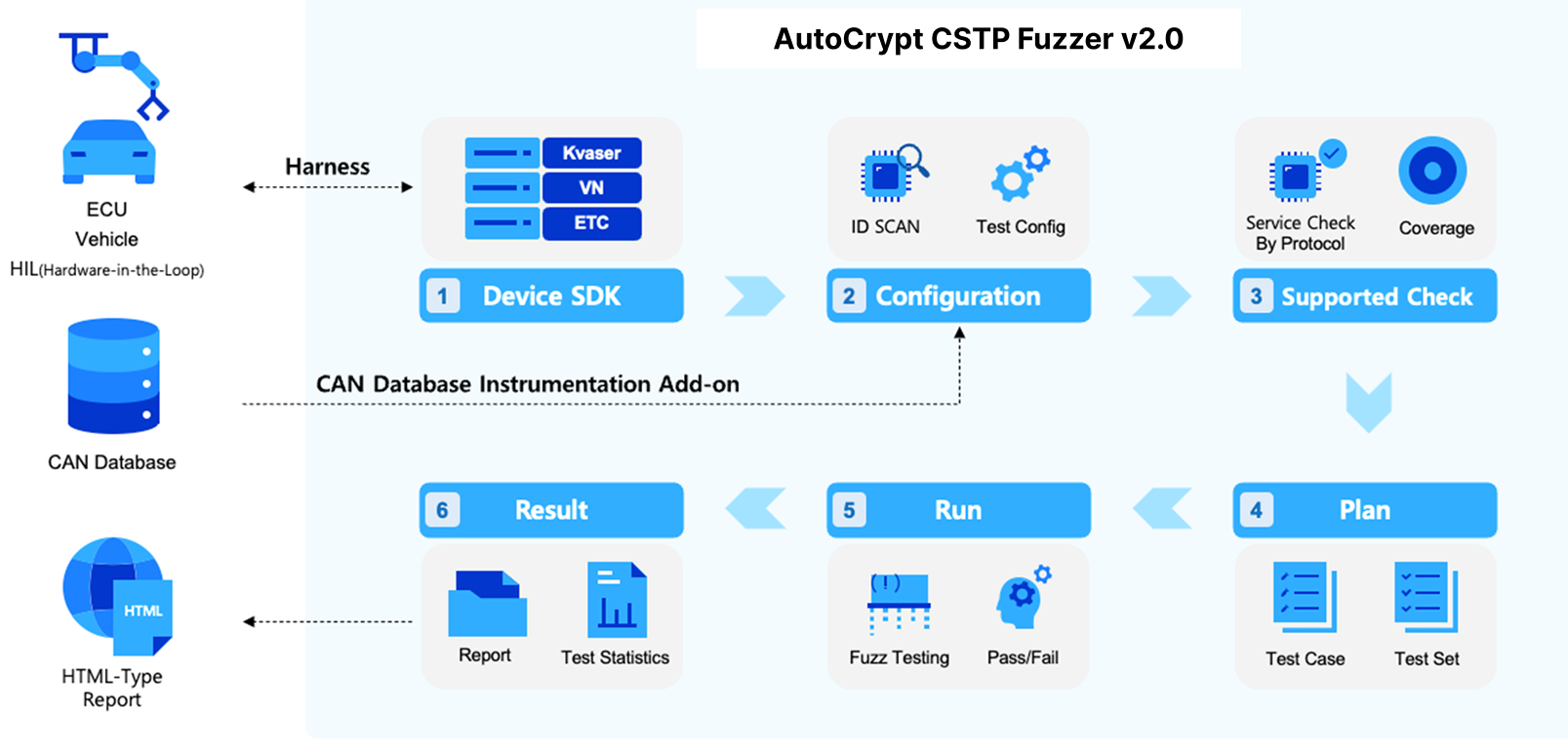Security Testing Tools
AutoCrypt CSTP Fuzzer
Smart and efficient fuzz testing tool based on automotive protocols,
available for physical and HIL simulation environments

Assess and address vehicular software risks through fuzz testing
Fuzz testing, or fuzzing, is a software testing technique that reveals hidden coding flaws and implementation bugs by injecting unexpected data inputs into a targeted program. The program’s responses and outputs (e.g. error messages) are then analyzed for potential vulnerabilities.
AutoCrypt® CSTP Fuzzer is a fuzz testing tool designed for the automotive system environment, making it a highly effective and efficient solution for vehicle testing as required by UN R155 and ISO/SAE 21434. Its proprietary fuzzing algorithms and test cases are built based on the structures of Unified Diagnostics Services (UDS), with extended support for a variety of protocols including CAN, Wi-Fi, Bluetooth LE, and Ethernet.
Regulatory Compliance for Vehicle Type Approval
AutoCrypt Security Fuzzer provides effective testing with extensive coverage as required by UNECE Regulation 155 and ISO/SAE 21434, making it essential for acquiring vehicle type approvals.
Recommended for
- OEMs
- Tier-1 suppliers
- Software providers
Technical standards
- Diagnostic services based on ISO 14229
- NRC testing based on ISO 14229
- CAN-TP support based on ISO 15765
UN R155
ISO/SAE 21434
How It Works
AutoCrypt CSTP Fuzzer generates in-vehicle protocol-based test cases, compliant with ISO 14229 UDS) using smart fuzzing techniques.
Unlike traditional fuzz testing that relies on random inputs, AutoCrypt CSTP Fuzzer leverages AI-based algorithms to automate testing, consequently increasing vulnerability detection rates while reducing testing time.
The test can run independently in the background, enabling continuous long-term testing, optimizing the entire process.

Feature Highlights
Common Features
Continuous Multi-ECU Testing
Ensures high availability through systematic project management and continuous testing technology.
Failure Retest Functionality
Allows easy reproduction of test cases for abnormal scenarios.
UDSonCAN / UDSonCAN-FD
Specialized Test Case Modeling
Generates test cases based on vehicle technical specifications to inject only meaningful data into the target
Automatic ECU Status Recovery
Enables sustainable testing through proprietary automated recovery logic during unexpected scenarios
Accurate Diagnostic Services Acceptance
Precisely validates applied services to ensure efficient testing
Advanced Evaluation Logic
Identifies issues in greater detail and provides intuitive detection results
VehicleCAN / VehicleCAN-FD
Exclusive Support for the VehicleCAN Protocol
Instead of injecting random data, it precisely targets anomaly injection areas based on the CAN database (CAN DB).
Custom Test Case Generation
Enables generation of test cases by specifying defined signal data frames and evaluation criteria.
VehicleCAN-Specific Fuzzing
Provides fuzz testing tailored to VehicleCAN characteristics using signal monitoring and test configuration data.

Related Product
AutoCrypt CSTP
AutoCrypt CSTP is a comprehensive platform that offers a variety of security tests and validations and allows them to be executed and managed on one single platform.

About AUTOCRYPT
AUTOCRYPT
AUTOCRYPT is a mobility security provider with the goal of providing a seamless and secure mobility experience for all.
